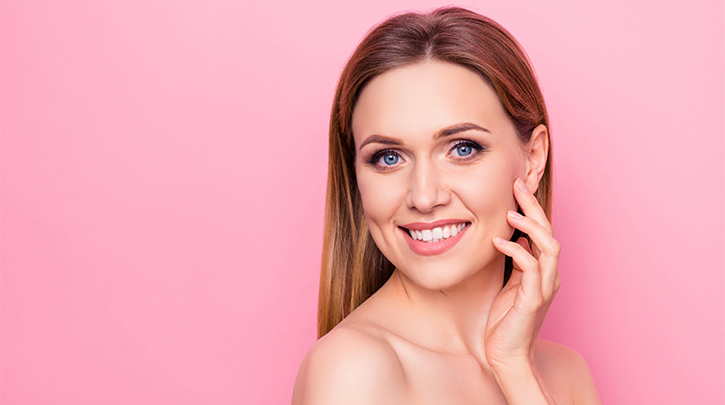
- Global
Get non-surgical solutions for today's top aesthetic concerns with Venus Treatments. Join thousands of satisfied patients worldwide!
- Loading...
- All Regions
Get non-surgical solutions for today's top aesthetic concerns with Venus Treatments. Join thousands of satisfied patients worldwide!

You’re never too “old” or “wrinkled” to start an anti-aging skin care regimen. In fact, anti-aging skin care may be more important than ever once wrinkles appear or elasticity fades. With skin’s natural collagen production levels declining 1% annually starting around the age of 25, anti-aging skin care in our later years certainly won’t prevent every little wrinkle. It should, however, be approached as a way to help boost and support healthy cell renewal and prevent further damage. In other words, anti-aging skin care is all about treating skin to a little TLC at any age, even if skin hit its peak more than a decade ago.
In the first part of this anti-aging skin care series, we offered up tips for preventing premature signs of aging in your teens, 20s, and 30s . Here, we’re focusing on anti-aging tips to prevent damage and support skin health in your 40s, 50s, and beyond.
During our 40s, collagen and elastin levels continue to decline, and cell renewal is much slower. At this time, age spots, dry and uneven skin texture, and the cumulative effects of sun damage start to show. (Even if you managed to wear sunscreen daily, as you should, it isn’t a failsafe for lounging in the sun for hours on end.)
While we recommend easing yourself into a retinoid routine in your 30s, if you’re still sticking to a low-concentration, over-the-counter anti-aging retinol serum, now is the time to bump that up to a tretinoin serum. Contact a dermatologist to obtain a recommendation on what concentration and specific skin care product may be right for your skin.
While you’re there, consider outfitting your entire skin care routine with anti-aging boosters. These products offer a helping hand to support continued collagen production and improved cell renewal as skin’s ability to do so on its own naturally declines. To improve dry or uneven skin texture, opt for a chemical exfoliant, ideally one containing an alpha-hydroxy acid (AHA). AHAs improve the appearance of wrinkles and promote collagen production, while helping slough off dead skin cells and smoothening texture in preparation for restoring anti-aging creams. One important note is to reserve exfoliating for your evening anti-aging routine, as AHAs will increase skin’s photosensitivity. For an everyday cleanser, look for a creamy texture that’s gentle on skin for the mornings and follow it up with your retinoid serum, an antioxidant-rich moisturizer, then a higher SPF sunscreen for the day. With skin beginning to thin at this age, these steps will help to improve moisture and texture, while preventing further sun damage.
For an added boost in repairing skin texture or removing age spots, a customized series of Intense Pulsed Light (IPL) photofacial treatments or radio frequency (RF) skin resurfacing treatments may do the trick. Photofacial treatments utilize IPL technology to target pigmentation in the skin and break up pockets of melanin for a more even tone. Skin resurfacing treatments, by comparison, are best for treating textural irregularities like scars or rosacea. Utilizing tiny pins, they deliver RF energy deep below the skin’s surface, creating tiny micro-dermal wounds while prompting skin’s natural healing cycle to smoothen and repair. Both treatments are also options for treating fine lines and wrinkles.
In your 50s, deep wrinkles and a more dramatic loss of volume in the skin will become much more apparent. Menopause and skin’s natural aging cycle are to blame, as cell turnover slows way down, and skin’s natural structures begin to deteriorate. Rather than tossing your anti-aging toolkit and letting the wrinkles come, it’s time to focus in on damage prevention and collagen and elastin production support.
For damage prevention, wearing sunscreen every single day is not something to compromise. Every little bit of sunlight can cause visible damage to skin structures that will take even longer to heal (if they do at all) at this age, so bump up the SPF and never skip applying or reapplying it.
To add to the list, menopause can also wreak havoc on sebum production and cause adult acne breakouts as hormones fluctuate. Similar to when you were in your 20s, gentle treatments to reduce the appearance of current breakouts and prevent future ones are ideal. Opt for spot treatments or IPL acne treatments, rather than moisture-zapping acids in every step of your skin care routine. Pair these treatments with a creamy, gentle cleanser and a thicker moisturizer full of nourishing essentials and antioxidant powerhouses like niacinamide and vitamins B and E.
There are also plenty of non-invasive treatment options available. Fillers may help to temporarily restore lost volume, while customized wrinkle reduction treatments will help boost collagen and elastin levels. Powered by advanced radio frequency technology, these treatments generate heat deep below the skin’s surface to stimulate collagen production and kickstart the natural healing cycle, promoting cell renewal for smoother, younger-looking skin.
To learn more about anti-aging wrinkle reduction, IPL acne reduction, skin resurfacing, or alternative non-invasive anti-aging treatments to give your aging skin the support it needs, contact a certified treatment professional near you using the search field below.
Find a certified Venus Treatments provider near you today who specializes in today’s top aesthetic medical solutions.



Search below to find a provider near you and to learn about our non-surgical aesthetic treatments with ARTAS®, NeoGraft®, Venus Bliss™, Venus Blilss MAX™, Venus Versa™, Venus Legacy™ Venus Versa™ Pro, Venus Velocity™, Venus Viva™ MD, and Venus Glow™.
For more information call: (888) 907-0115 // [email protected] // 235 Yorkland Blvd., Suite 900, Toronto, ON, M2J 4Y8 Canada
REGULATORY CLEARANCES [ More ]
Venus Bliss™ is cleared by the FDA and licensed by Health Canada for non-invasive lipolysis of the abdomen and flanks in individuals with a Body Mass Index (BMI) of 30 or less, with the diode laser applicators. The (MP)2 applicator is cleared by the FDA for temporary reduction in the appearance of cellulite, and licensed by Health Canada for temporary increase of skin tightening, temporary circumferential reduction, and temporary cellulite reduction. Venus Bliss™ has CE Mark as a non-invasive medical aesthetic device enabling a comprehensive approach leading to body contouring, addressing fat reduction, skin tightening, circumference reduction, and cellulite reduction.
Venus Versa™ is cleared by the FDA, licensed by Health Canada, and has CE Mark as a multi-application device intended to be used in aesthetic and cosmetic procedures. The SR515 and SR580 applicators are cleared by the FDA, licensed by Health Canada, and have CE Mark for the treatment of benign pigmented epidermal and cutaneous lesions and treatment of benign cutaneous vascular lesions. The HR650/HR650XL and HR690/HR690XL applicators are cleared by the FDA, licensed by Health Canada, and have CE Mark for the removal of unwanted hair and to effect stable long-term or permanent hair reduction for Fitzpatrick skin types I-IV. The AC Dual applicator is cleared by the FDA, licensed by Health Canada, and has CE Mark for the treatment of acne vulgaris. The DiamondPolar™ and OctiPolar™ applicators on the Venus Versa™ system are cleared by the FDA for non-invasive treatment of moderate to severe facial wrinkles and rhytides on females with Fitzpatrick skin types I-IV. The DiamondPolar™ applicator is licensed by Health Canada and has CE Mark for non-invasive treatment of moderate to severe facial wrinkles and rhytides on females with Fitzpatrick skin types I-IV. The OctiPolar™ applicator on the Venus Versa™ system is licensed by Health Canada and has CE Mark for temporary body contouring via skin tightening, circumferential reduction, and cellulite reduction. The NanoFractional RF™ (Viva) applicator is cleared by the FDA, licensed by Health Canada, and has CE Mark for dermatological procedures requiring ablation and resurfacing of the skin.
NeoGraft® is cleared by the FDA, licensed by Health Canada and has CE Mark with indication for use in suction-assisted follicular extraction and re-implantation. It is an auto-graft system and can be used on both male and female patients.
ARTAS iX™ is cleared by the FDA, licensed by Health Canada and has CE Mark with indication for use for harvesting hair follicles from the scalp in men diagnosed with androgenic alopecia (male pattern hair loss) who have black or brown straight hair. ARTAS iX™ is intended to assist physicians in identifying and extracting hair follicular units from the scalp during hair transplantation; creating recipient sites; and implanting harvested hair follicles.
Venus Legacy™ is cleared by the FDA for the non-invasive treatment of moderate to severe facial wrinkles and rhytides in females with Fitzpatrick skin types I-IV with the OctiPolar™ and DiamondPolar™ applicators, and temporary reduction in the appearance of cellulite with the 4D Body (LB2) and 4D Face (LF2) applicators. It is licensed by Health Canada and has CE Mark for the temporary increase of skin tightening, temporary circumferential reduction, temporary cellulite reduction, and temporary wrinkle reduction.
Venus Velocity™ is cleared by the FDA, licensed by Health Canada and has CE Mark for hair removal, permanent hair reduction (defined as the long-term stable reduction in the number of hairs re-growing when measured at 6, 9 and 12 months after the completion of a treatment regimen), and the treatment of pseudofolliculitis barbae for all Fitzpatrick skin types.
Venus Fiore™ received regulatory approval in Israel for aesthetic and functional treatment of the vagina, labia and mons pubis. Venus Fiore™ is available for sale in India, Hong Kong, and other selected Asian countries.
Venus Viva™ is cleared by the FDA, licensed by Health Canada, and has CE Mark for dermatological procedures requiring ablation and resurfacing of the skin. The DiamondPolar™ applicator is cleared by the FDA, licensed by Health Canada and has CE Mark for the treatment of moderate to severe wrinkles and rhytides in Fitzpatrick skin types I-IV.
Venus Freeze Plus™ is cleared by the FDA for the non-invasive treatment of moderate to severe facial wrinkles and rhytides in females with Fitzpatrick skin types I-IV. It is licensed by Health Canada for temporary skin tightening, and temporary reduction in the appearance of cellulite on the abdomen and flanks, using the DiamondPolar™ and OctiPolar™ applicators. The DiamondPolar™ applicator on Venus Freeze Plus™ has CE Mark for the non-invasive treatment of moderate to severe facial wrinkles and rhytides, and the increase of skin tightening, temporary circumferential reduction, and cellulite reduction with the OctiPolar™ applicator.
Venus Heal™ is licensed by Health Canada and can be used for the treatment of both acute and chronic disorders of the musculoskeletal system, such as muscle spasms, back pain, and soft tissue injuries, and results in effects such as pain relief, myorelaxation, increase of local blood circulation, and edema reduction. In the U.S., Venus Heal™ is cleared by the FDA for the relief of minor muscle aches and pain, relief of muscle spasm, and temporary improvement of local blood circulation. These indications enable the treatment of certain soft tissue injuries and conditions.
Venus Glow™ is cleared by the FDA as a Class I motorized dermabrasion device. It provides a dermal rejuvenation treatment that works to open up and deep-clean pores. Venus Concept is the exclusive distributor for Venus Glow™.
Venus Epileve™ is licensed by Health Canada and has CE Mark for hair removal, permanent hair reduction (defined as the long-term stable reduction in the number of hairs re-growing when measured at 6, 9 and 12 months after the completion of a treatment regimen), and the treatment of pseudofolliculitis barbae for all Fitzpatrick skin types. Venus Epileve™ is also CE-Marked for hirsutism.
Venus Freeze™ is cleared by the FDA for the non-invasive treatment of moderate to severe facial wrinkles and rhytides in females with Fitzpatrick skin types I-IV. It is licensed by Health Canada for temporary skin tightening, and temporary reduction in the appearance of cellulite on the abdomen and flanks, using the DiamondPolar™ and OctiPolar™ applicators. The DiamondPolar™ applicator on Venus Freeze™ has CE Mark for the non-invasive treatment of moderate to severe facial wrinkles and rhytides, and the increase of skin tightening, temporary circumferential reduction, and cellulite reduction with the OctiPolar™ applicator.
Venus Swan™ is cleared by the FDA for the non-invasive treatment of moderate to severe facial wrinkles and rhytides, and licensed by Health Canada for the non-invasive treatment of cellulite reduction, skin tightening, and temporary reduction in the appearance of stretch marks.
Copyright © 2024 Venus Concept. All rights reserved.
You are entering our website. For other countries/regions and language options, please click the SELECT A DIFFERENT REGION button below.
SELECT A DIFFERENT REGIONAre you looking to get a treatment? Please visit our patient website to learn more.
Click HereUnsure which aesthetic treatment is right for you? Take this quick and easy quiz to discover treatments that suit your needs.
Get Started